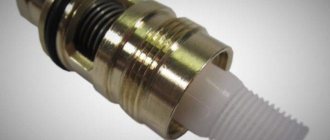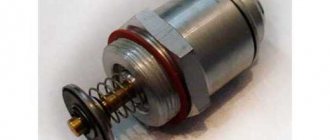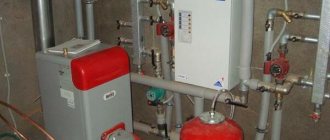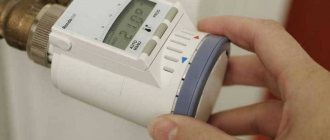Gas boilers are reliable equipment that supply our country houses and some city apartments with heat and hot water. Unfortunately, they cannot work completely without breakdowns. And violations often include valves—devices for protecting and supplying fuel to units.
We will tell you how and what kind of gas boiler valve repairs you can do yourself. We will analyze in detail the situations that signal the occurrence of related disruptions in work. We’ll tell you whether it’s worth making your own efforts or whether it’s better to turn to gas workers.
In our article you will find step-by-step guides to restoring the performance of gas boilers by repairing or replacing the gas, safety and three-way valves.
EGC device
The gas solenoid valve consists of electrical and mechanical elements. Electrical parts control the system, and mechanical parts execute commands. The device circuit is located in the housing.
Solenoid valve design:
- frame;
- plunger;
- solenoid (electric coil);
- piston;
- stock;
- lid.
Due to the fact that gas safety shut-off valves have a low operating pressure, they are most often made of metal and alloys (cast iron, brass, aluminum), as well as polymers (nylon, ecolon, polypropylene).
Plungers and rods are made from special magnetic materials. The coils use a sealed housing that protects against dust and short circuits. The winding of the solenoids is made with high-quality enameled wire, for which electrical copper is used.
The device is connected to the gas pipeline with a flange or threaded connection, and is connected to the electrical network with a plug.
Principle of operation
The EGC is a hydraulic element that regulates gas flow by applying voltage to a valve coil.
The operating principle of the gas valve is the same as that of a conventional faucet. The gas is shut off at the touch of a button. If harmful and strong vibrations occur or gas leaks, it closes automatically.
The core, connected to the saddle of the device, is drawn into the coil by the acting electromagnetic forces and opens the access of gas. During operation, the device is affected by two forces. On the one hand, this is the resistance of the return spring, and on the other, the strength of the magnetic field, which is regulated by electrical voltage. The stronger it is, the greater the force that overcomes the action of the spring. Therefore, adjusting the voltage supply makes it possible to increase or decrease the degree of opening or closing of the device, and therefore the gas supply. This allows you to adjust the performance of the unit by increasing or decreasing its power.
When the power is turned off, the EGC returns to its original position, which is determined depending on the design.
ความคิดเห็น • 0
Yeah, but if the dielectric is pierced between the thread and the central terminal, it will also indicate a short circuit
Thank you! The parts are similar to those of the AOGV 11.6 Rostov.
You're calling incorrectly
I soldered the thermocouple directly at the contact point, and I never have any more problems with it.
The video is certainly old, but questions will still arise. I’ll share my experience, and then it’s up to everyone. I start the test by inspecting the thermocouple while the pilot light is burning. The igniter flame should flow well around the tip of the thermocouple, and the thermocouple itself should be intact without any damage or indentations. The tightness of the contacts between the thermocouple and the electromagnet is also checked. The union nut 14 must be tightly tightened on the thermocouple side and on the side of the draft sensor and temperature fuse. You can ring the right side of the electromagnet, which is responsible for the temperature and traction sensor, using an indicator screwdriver. In the AOGV kit, they sometimes sell a plug for the right side of the magnetic box (as they say in the spare parts catalog), then you can check the serviceability of the electromagnet by screwing on this plug and igniting the pilot burner. If after this the electromagnet “does not grab” and does not attract the round core with the rod inside, then you need to check the contacts that Magomed Khamzalatov wrote about by examining them and trying to rotate them relative to the electromagnet body (they should be firmly soldered). As an option, sometimes I remove the thermocouple along with the electromagnet and the round core, heat it on a gas burner and test it in action. I beg to differ with Magamed regarding the aging of the membrane, because... when it becomes stale, the igniter ignites without pressing the start button, and in some cases it can cause a gas leak above the gas block. Solder the threads carefully, because... The gasket between the contact tin and the cut threaded tube is made of plastic and can melt. You can also check the functionality of the magnet using a AA battery, then you won’t have to heat anything on a gas burner.
Thank you! Make your own channel on YouTube!!
I made a special bracket and now I have it pressed all the time and I don’t care, but buying a new one is a waste of money.
The gas will disappear and the fuse will blow out Pisa for everyone
It is not rational if, for example, the flame is blown out by the wind, and the gas continues to flow to the burners and spread throughout the house.
Greetings! Where can I buy a thermostat for AGV 80?
This coil works on simple Aogv boilers, what is the advantage of accessibility, ease of replacement and repairs to faults are visible to the naked eye, and it can be done directly easily, but it’s better not to do it, call mechanics and they’ll do everything
Better yet, call the mechanics and replace the boiler.
Good afternoon. We need your professional advice. Why does the steam stop on the steam table when you turn on (press the button) the steam iron, but when the button is turned off, the steam flows. (It should be in reverse) In my opinion, the solenoid valve works in reverse. Why. Thank you in advance.
If you have replaced the solenoid valve with Eurosit 630, it would be interesting to watch the video. Thank you.
Application of EGC
Gas valves are widely used in everyday life and industry. In the industrial sphere, they are used in equipment ensuring gas safety, in earthquake detection systems, and can be installed in parallel with gas alarm equipment.
In everyday life they are used to control the supply of gas to dispensers, gas boilers, stoves, and when introducing pipes into residential high-rise buildings. They are equipped with gas cylinders when installing automobile gas cylinder devices.
Designed for pipelines with non-aggressive media, including natural gas, propane, liquefied petroleum gas (LPG).
Automatic blocks of floor-standing boilers
The vast majority of floor-standing gas boilers are equipped with automatic safety systems that operate without an external power source (non-volatile). According to the requirements of regulatory documents, automation equipment must shut off the gas supply to the burner and igniter in three emergency cases:
- Extinction of the main burner flame due to blowing out or for other reasons.
- When natural draft in the chimney channel is absent or sharply reduced.
- The drop in natural gas pressure in the main pipeline is below a critical level.
For reference. The implementation of the listed functions is mandatory for gas boilers of all types. Many manufacturers add a fourth level of safety – overheating protection. When the coolant temperature reaches 90 °C, the valve, based on a signal from the sensor, stops supplying gas to the main burner.
Various models of gas floor-standing boilers from different manufacturers use the following types (brands) of non-volatile automation:
- Italian blocks EuroSIT (Eurosit) series 630, 710 and 820 NOVA (heating units Lemax, Zhitomir 3, Aton and many others);
- Polish devices "KARE" (heat generators "Danko", "Rivneterm");
- American automatic control devices Honeywell (Zhukovsky heaters);
- domestic products, "Arbat".
Fuel supply system in the simplest AOGV devices equipped with ZhMZ valves.
The burner is hidden in the lower part of the housing. We have listed the most common brands of automation, which are often installed on water heating boilers from the same company. For example, the Zhukovsky plant equips budget versions of AOGV devices with its own ZhMZ safety units, mid-price heat generators with EuroSIT devices, and powerful models with Honeywell automatic valves. Let's look at each group separately.
SIT Group brand gas valves
Of all the types of automation found in boiler installations, EuroSIT safety units are the most popular and reliable in operation. They are recommended by companies that supply natural fuels, including for replacing old gas equipment of KChM, AGV boilers, and so on. They work without problems as part of micro-flare burners Polidoro, Iskra, Vakula, Thermo and others.
The exact names of the three models used look like this:
- 630 SIT;
- 710 MiniSIT;
- 820 NOVA.
The thermocouple, main and pilot burner connection sockets are located on the bottom panel of the valve
For reference. SIT Group has ceased production of the 630 and 710 series, considering them obsolete. This has been replaced by new safety automatics for heating boilers - gas valves 820 NOVA, 822 NOVA, 840 SIGMA and 880 Proflame (battery operated). But old products are not difficult to find on sale.
In order not to bore you with the design details of automatic EuroSIT devices, let us briefly explain the operating principle using the example of a simple 630 series unit:
- When you turn the handle to the “ignition” position and press from above, you forcibly open the solenoid valve, which allows gas to flow to the pilot burner (igniter). You click the button on the piezoelectric element, which produces a spark that ignites the wick.
- By holding the main handle for 30 seconds, you allow the thermocouple to be heated by the pilot flame. The thermal balloon produces a voltage (EMF) of 20-50 millivolts, which fixes the electromagnet in the open state. Now you can release the handle.
- Set the main handle to the desired position and thus supply gas to the main burner. The latter ignites and begins to heat the heat exchanger with water from the heating system, as shown in the diagram.
- When the water reaches a certain temperature, the capillary sensor is activated, gradually closing the second valve - the thermostatic one. The supply of fuel to the burner device stops until the sensor cools down and the valve plate opens the path for gas. The igniter continues to burn in standby mode.
Note. Older automation modifications were not equipped with temperature sensors and ignition units, so matches were required to start the heat generator.
A membrane valve, which plays the role of a pressure regulator, is responsible for the normal gas supply in the device. When it falls below a preset value, the fuel channel closes and an emergency shutdown of the boiler occurs. Other situations that lead to refusal include:
- The burner and the wick heating the thermocouple go out. Voltage generation stops, the solenoid valve closes the fuel passage.
- If the draft in the chimney suddenly disappears, the sensor placed in this channel overheats and breaks the power supply circuit of the electromagnet. The result is similar - the fuel supply is blocked.
- In heaters equipped with overheating sensors, the electrical circuit is broken after the water reaches a temperature of 90-95 °C.
When the gas automatic system triggers an emergency shutdown, the user is blocked from restarting the boiler for 1 minute; before that, the fuel supply will not resume. The operation of the system is clearly reflected in the training video:
Differences between models 710 MiniSIT and 820 NOVA
According to the principle of operation, these units do not differ from their predecessor - the 630 series. Changes to the 710 MiniSIT automation are purely constructive:
- 2 buttons “Start” and “Stop” are placed separately along with the solenoid valve;
- the main handle only rotates the thermostat rod and regulates the temperature of the coolant;
- the ignition unit with a piezo igniter button is built into the product body;
- The basic package of the device includes a bellows-type temperature sensor with a capillary tube;
- added gas pressure stabilizer.
Types and groups of gas valves
EGCs differ in design features, which determines their classification:
- by type of execution - normally closed or normally open;
- by type of working medium - for water, gas, air, steam, fuel;
- according to operating features - conventional and explosion-proof;
- according to the principle of action - direct, indirect, combined.
Depending on the number of strokes of the saddle, the devices are:
- single-stage or one-pass.
The valve can be in the open or closed position. Having received an electrical signal, it opens completely and ensures the passage of the required amount of fuel; - two-stage or two-pass.
EGC may be in an intermediate position. This is necessary for a smooth start of the burner. The valve, which is partially opened, opens completely after a certain time and ensures the operation of the equipment in the maximum permissible mode. Partial opening results in a stable flame on the burner; - three-stage or three-way.
This type of solenoid valve is equipped with devices with 2 power levels. In this design, the first stroke starts the unit, the second repeats the functions of the first stage of two-stage devices, and the third ensures that the equipment operates at full power; - modulating.
In this case, the device is equipped with modulating gas valves in which the seat opens to a user-specified position.
According to the type of control, valves are:
- with manual control.
These are simple designs whose shutter is activated by turning a control wheel or lever. Such devices are highly reliable and low cost; - automatic.
The design of such models is equipped with an electric drive, which allows you to control the device from a distance. Most often used in industrial facilities: gas pipelines, heating networks, production lines.
Based on their functional purpose, the following types of gas valves for boilers and other devices are distinguished:
- back.
Protects the pipeline from gas circulation in the opposite direction. A check valve mechanism allows current to flow in only one direction; - safety.
It is a protective device that prevents emergency situations due to a sharp pressure drop in the gas pipeline.
Manufacturers
Let's look at the most popular companies that produce gas valves.
Dungs
A German company that is one of the most popular in the production of gas control valves.
Dungs products began appearing on the Russian market in 1999 and were able to firmly consolidate their position. Users constantly purchase products from this manufacturer because they are distinguished by high quality, reliability and long service life.
Double gas valve device DUNGS type DMV
The only drawback that can be noted is the high price.
The most technologically advanced development of the Dungs company in the mass segment is the Dungs DMV-D valve - this is a two-way device, which, in fact, is a connection of two independent valves in one compact body. Thanks to its technical characteristics, it can function in high pressure working environments (up to 500 mbar). The cost of devices starts at approximately 12,000 rubles.
Benefits and Features
The device differs:
- reduced energy consumption;
- long service life;
- reliability of the design, which ensures convenience and ease of operation.
The main feature of the product is that you do not need to apply any effort to open and close the valve. The control is carried out by an electromagnetic coil, which is triggered by the supply of electric current. EGC's automatic response to emergency situations makes the use of natural gas safe.
The second feature of the solenoid valve is the ability to clean the working environment from small solid particles: dust, organic debris, metal shavings.
How to choose the right model?
To choose the right device, you need to decide where it will be used and what characteristics it should have.
When purchasing, you need to pay attention to the following properties:
- electrical service.
It is desirable that the device be intrinsically safe, low power, with additional manual adjustment; - pressure.
When choosing a valve, it is necessary to take into account that the pressure in the system should not be higher than the nominal pressure of the device. Otherwise, the mechanism may be damaged; - external environment.
Environmental conditions (humidity, temperature changes, exposure to ultraviolet radiation, vibration) must match the characteristics of the device. External factors can adversely affect the entire device and its individual elements; - network voltage.
It is necessary to pay special attention to this indicator, since low or high voltage can lead to incorrect operation of the mechanism or its failure; - connecting dimensions.
When purchasing, you must take into account the diameter and type of thread, which must correspond to the parameters of the main pipeline.
Gas boiler does not heat hot water
Water flow (flow) sensor for gas boiler Protherm Gepard (Panther)
The DHW water flow (flow) sensor is a rotating turbine with blades, the rotation speed of which depends on the intensity of water flow. From the operating experience of Protherm Gepard (Panther) gas boilers, it is known that a frequent cause of failure of the DHW heating function in these boilers is the turbine stopping due to foreign particles entering it. Although the turbine is protected from clogging by a mesh filter, it does not always cope with its task.
If, when you open the hot water tap, the boiler burner does not ignite and cold water flows from the tap, then check the serviceability of the DHW flow sensor. It is necessary to call line d.36 of the service menu, which displays the flow sensor readings. If, when the hot water tap is open, the flow readings in line d.36 are equal or close to zero, then we conclude that the flow sensor is not working.
The location of the water flow sensor is indicated by the green arrow in the figure above.
The water flow sensor is removed by pulling the fixing steel bracket to the left. After removing the bracket, you need to pull the sensor towards you and pull it out of the socket. Before removing the sensor, it is necessary to drain the water from the DHW circuit of the boiler, as described above.
To avoid failures in the operation of the flow sensor, it is recommended to supply water to the boiler through an additional tap water filter installed in front of the boiler.
Installation of the device
The installation of a shut-off valve into the gas system must be carried out by specialists who have special approvals that allow them to perform this type of work and other permitting documentation.
The installation location is selected so that there is easy access to the device for manual cocking.
It is recommended to install EGC:
- in front of the gas meter, if the design allows;
- in front of a gas appliance: stove, boiler, water heater;
- at the system entrance to the room where there is a gas meter with a shut-off mechanism. The distance from the entry point must be more than 10 m.
Installation may require additional consumables, which must be purchased in advance.
Connection of solenoid valves must be carried out in compliance with all manufacturer’s recommendations and adhere to the requirements of standards and regulations.
Ignition transformer
This element supplies the burner with a current discharge (spark), which is necessary to ignite the fuel. In addition to other elements that directly affect the operation of the unit, the component can also fail. As a result, all automation will work, but fire will not appear, since there is no source of ignition.
How can you quickly check the ignition transformer of a gas boiler for functionality? Just. You need to make a few simple movements:
- Through a special window, see whether the discharge is going on or not.
- Using a tester, check the voltage coming out of the controller during the ignition attempt. A figure falling within the range from 187 to 235V is considered normal.
- If a problem is detected, you need to disconnect the power from the transformer and connect it back.
- Check again.
Any gas boiler is equipped with many safety elements and sensors that allow you to monitor the correct operation of the unit. In the event of situations that clearly threaten human life, the system completely shuts down the installation.
In case of any breakdown, most owners of a gas water heater call a specialized service technician. However, services usually come with financial costs, right?
Where to buy EGC?
If you are interested in high-quality solenoid valves, please contact. Our catalog includes a wide range of industrial drive equipment from European manufacturers. We offer a large selection of sensors, automation systems, recorders and power supplies for various purposes.
You can make a purchase from our company without much difficulty. The prices for gas appliances will pleasantly surprise you, and registration will require a minimum amount of time.
For additional information about gas valve models and their characteristics, please contact our managers by calling +375 (17) 513-99-92.
Wall unit electronics
A special feature of these heat generators is electronic control of the processes of ignition, combustion and maintenance of coolant temperature. That is, wall-mounted gas boilers (and some floor-standing ones) are equipped with energy-dependent automation powered by electricity.
Important point. Despite the many bells and whistles introduced into the design of mini-boiler houses, safety functions are still in charge of the mechanics. The three types of emergency situations listed above will be processed by the equipment regardless of the presence of voltage in the electrical network.
An automatic gas boiler was created for maximum convenience for owners of apartments and private houses. To start the heater, just press 1 button and set the desired temperature. Let us briefly describe the operating algorithm of the unit and the elements involved in it:
- After these startup steps, the heat generator controller collects sensor readings: coolant and air temperature, gas and water pressure in the system, and checks the presence of draft in the chimney.
- If everything is in order, the electronic board supplies voltage to the electromagnetic gas valve and at the same time a discharge to the ignition electrodes. The wick is missing.
- The main burner ignites and gives full power in order to heat the coolant as quickly as possible. Its operation is monitored by a special flame sensor. The controller includes a built-in circulation pump.
- When the coolant temperature approaches the set threshold, which is recorded by the overhead sensor, the combustion intensity will decrease. Staged burners switch to low power mode, and modulating burners smoothly reduce the fuel supply.
- Having reached the heating threshold, the electronics will shut off the gas. When the sensor detects cooling of the water in the system, automatic ignition and heating will be repeated.
Note. In turbocharged boilers with a closed combustion chamber, the controller also starts and turns off the fan.
The instructions for the wall-mounted gas boiler indicate that the unit is designed to operate in a closed heating system, so the automation monitors the water pressure. If it drops below the permissible limit (0.8-1 Bar), the burner will go out and will not light until the problem is corrected.
Many imported boilers operate according to an energy-dependent scheme, for example, Buderus Logano, Viessmann and so on. How the installation of electronic gas equipment occurs, the master will tell you in an accessible language in the video:










